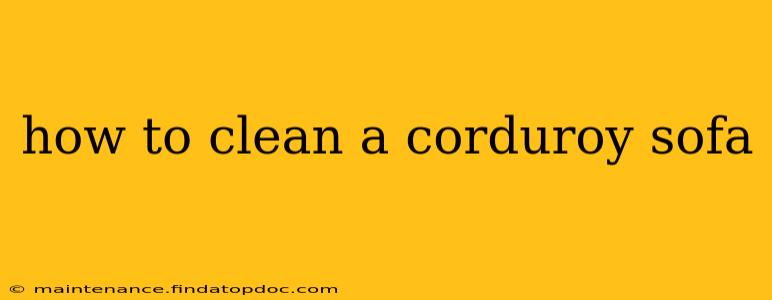Corduroy sofas offer a rich texture and classic style, but their velvety ridges can be tricky to clean. Spills and dust are a constant threat, requiring a delicate touch to avoid damaging the fabric. This comprehensive guide will walk you through various cleaning methods, addressing common concerns and ensuring your corduroy sofa remains looking its best. We'll cover everything from quick spot cleaning to deep cleaning, and address specific concerns based on what people often ask about cleaning corduroy.
What's the Best Way to Clean a Corduroy Sofa?
The "best" way depends on the type of stain and the severity of the soiling. For everyday dust and light dirt, vacuuming is sufficient. For spills and stubborn stains, spot cleaning is necessary. For deep cleaning, professional cleaning is often recommended to avoid damage to the fabric. Always test any cleaning solution on an inconspicuous area first (like the underside of a cushion) to ensure it doesn't cause discoloration or damage.
How Do You Get Stains Out of a Corduroy Sofa?
Tackling stains promptly is crucial. The longer a stain sits, the harder it will be to remove. Here's a breakdown of stain removal techniques:
1. Act Fast: Blot (don't rub!) any spills immediately with a clean, absorbent cloth. Rubbing will only spread the stain and potentially damage the fabric.
2. Identify the Stain: Different stains require different treatments.
-
Water-based stains (juice, coffee, etc.): Mix a mild detergent (like Woolite) with cool water. Apply the solution gently with a clean cloth, blotting to lift the stain. Rinse with a clean damp cloth and blot dry.
-
Oil-based stains (grease, oil): Sprinkle cornstarch or baking soda over the stain to absorb the oil. Let it sit for at least 30 minutes, then vacuum thoroughly. For stubborn stains, try using a dry-cleaning solvent specifically designed for upholstery.
-
Pet stains: Immediately blot up any liquid. Then, apply an enzymatic cleaner designed to break down pet stains and odors. Follow the cleaner's instructions carefully.
-
Ink stains: Use rubbing alcohol (isopropyl alcohol) sparingly, blotting gently. Test in an inconspicuous area first!
How Often Should You Clean a Corduroy Sofa?
Regular maintenance will keep your corduroy sofa looking its best and extend its life. Here's a suggested cleaning schedule:
-
Vacuum: At least once a week, using a soft brush attachment to remove loose dust and debris. Pay special attention to the crevices between cushions and along the seams.
-
Spot clean: As needed, immediately addressing spills and stains.
-
Deep clean: Every 6-12 months, depending on use and traffic. Consider professional cleaning for best results.
Can You Use a Steam Cleaner on a Corduroy Sofa?
While steam cleaning can be effective for some upholstery, it's crucial to exercise caution with corduroy. Excessive moisture can damage the fabric, leading to shrinkage or discoloration. If you opt for steam cleaning, use a low setting and maintain a safe distance from the fabric. Always test in an inconspicuous area first. Professional steam cleaning is often a safer bet.
How Do You Clean a Corduroy Sofa Without a Vacuum?
If you don't have a vacuum, you can use a lint roller or a damp (not wet) cloth to remove surface dust and loose debris. However, a vacuum is far more effective at removing deeply embedded dirt.
How Do You Get Rid of Pet Hair on a Corduroy Sofa?
Pet hair can be particularly tenacious on corduroy. A stiff-bristled brush, a lint roller, or a damp sponge can help remove surface hair. A vacuum cleaner with a specialized upholstery attachment is the most effective method for thorough hair removal.
Can I Use Bleach on My Corduroy Sofa?
Absolutely not. Bleach is harsh and will likely damage the fabric, causing discoloration and weakening the fibers. Never use bleach on corduroy upholstery.
By following these tips and techniques, you can keep your corduroy sofa clean, comfortable, and looking its best for years to come. Remember that prevention is key – using protective throws and coasters can significantly reduce the need for frequent cleaning. For significant stains or deep cleaning needs, professional upholstery cleaning is always a safe and effective option.
